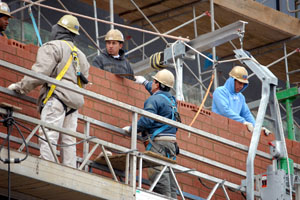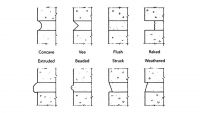Contractors and Building Codes

As a contractor, even before you start estimating a job, you know that the profit margin will be slim. Labor, equipment and material costs are on a steady increase year after year. Thus, the cost of doing business in the construction industry is getting more and more expensive. Naturally, as a businessperson, you look for ways to lower your expenses and overhead, producing more profit. In doing so, you may look at the amount of labor used and the cost of overtime, vehicles, construction equipment and masonry materials. In many cases, these are treated as fixed costs. This means that, since your margin is fixed, in order to increase profit, you must increase your volume. Masonry's volume of business is the percentage of total construction that is completed using masonry materials. This is the concept of market share.
What are some factors that affect masonry's market share? Many people immediately think about competitive materials, other mason contractors, or union versus non-union contractors. While all of these affect the masonry industry's market share, there is another very large factor that often is overlooked: building codes and standards.
Tom Young of the Northwest Concrete Masonry Association often uses the quote, "Building codes activities at the national and state level are often the single most effective manner to maintain and increase market share for construction materials and systems." There is no one thing that has a greater impact on the manner in which you do business than codes and standards, yet many contractors refuse to get involved in this process.
The national building codes are adopted by each state, making them a mandatory, minimum standard for designing structures. Imagine if overzealous designers were able to determine this minimum standard without any contractor participation. This is a harsh reality within the masonry construction world; the constructability of a masonry project usually is determined by designers who possess little, if any, masonry construction experience. Designers often hide this inexperience with performance specifications and shop drawing requirements for more difficult aspects of the design.
While this phenomenon is not new, it is becoming increasingly more difficult to build masonry structures as they are being designed currently. When situations such as these arise, who's at fault? The engineer has designed the structure according to the adopted building codes. The architect specified the project according to the ASTM standards and OSHA regulations. This leads to only one conclusion: The national codes and standards rarely are written with the contractor in mind. Taking this one step further, one could conclude that not only do the designers not have masonry construction experience, but the authors and developers of many building codes, standards and safety regulations do not possess this hands-on masonry construction experience either.
Often, contractors are encouraged to attend and participate in various code- and standard-writing committees, yet rarely do they show. However, when an impossible-to-build design crosses your desk that is designed using the current building code, you are frustrated and blame those engineers and professors. It's time to step up to the plate and work to develop codes, standards and regulations that will allow you as contractors to perform your jobs easier and with more efficiency.
While there has been some progress, there are still many issues within the building codes that adversely affect contractors.
Have you noticed...
- In some cases, rebar lap splice lengths can be up to half the height of the wall?
- Brick veneer is rarely over one story in high seismic areas?
- More and more steel reinforcement is being designed into the masonry unit core?
- There are few, if any, single-wythe concrete block walls still designed?
- Autoclaved Aerated Concrete (AAC) walls are rarely designed?
- Once the producer's (or distributor's) truck reaches the job site, it's yours? (Even if you haven't seen it!)
- You have to stand back 20 feet to accept your shipment of material?
- Five percent of all your units in a shipment can be broken?
- Once your mason places a brick in the wall — no matter how poorly it was manufactured — ASTM releases the producer from any liability?
- You could be required to pay for tests of materials?
- You may have to look at a unit to determine if it can carry the intended load?
Likewise, ASTM International has an open membership policy. Therefore, you can join this committee at any time and have an immediate impact. There are two committees that deal specifically with masonry materials. They are Committee C12 on Mortars and Grouts for Unit Masonry and Committee C15 on Manufactured Masonry Units. The cost to become a member of ASTM is $75 annually, and with that fee you receive a free volume of ASTM standards for masonry materials.
Also, the Occupational Safety and Health Administration (OSHA) has many committees that are open to contractors. Members of the Mason Contractors Association of America (MCAA) Safety Committee populate many of these committees. Again, there is no cost to be a part of these committees.
Did you know that if it were not for contractor intervention, OSHA would require...
- Bracing of masonry walls for up to 90-110 mph wind speeds?
- You to remove all materials from scaffolding at the end of each shift?
- You not to use Non-Stop or Morgen Scaffold?
- You to tie off when laying brick or block?
- Every mason to wear a respirator (dry or wet cutting)?
- Every contractor to provide a lunchroom and locker room facilities at every job site?
- Two masons to lift every concrete block?
- No use of man baskets on forklifts?
About the Author
Rashod R. Johnson, P.E., is president of The Roderick Group in Chicago. He is the former Director of Engineering for the Mason Contractors Association of America and currently serves as a technical consultant to the association.


















